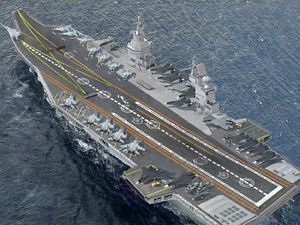The Krylovsky State Research Center (KRSC), a Russian shipbuilding research and development institute, has been pushing Russia’s Ministry of Defense (MoD) to sign off on its concept of a new nuclear-powered supercarrier, dubbed Project 23000E Shtorm (Storm), according to various Russian media reports.
Based on independent estimates the carrier could take seven to ten years to build and cost as much as $9 billion. The ship’s design was first revealed in May 2015. Based on information supplied by KRSC, the new supercarrier will displace 90,000-100,000 tons, and will be 330 meters long, 40 meters wide, and will have a draft of 11 meters.
The ship will be allegedly be powered by either conventional or a nuclear propulsion and can stay at sea for 90-120 days. The Shtorm carriers can reach top speeds of up to 30 knots (around 55 kilometers per hour) and accommodate a crew of up to 5,000. Furthermore, the ship would be able to carry 80-90 deck-based aircraft.
“The vessel will be able to carry a stock of jet fuel of up to 6,000 tons (…). Storm Project aircraft carrier will be able to carry up to 90 aircraft and helicopters. The main power plant of the ship will operate on organic fuel,” a KRSC representative told Russian media on March 20.
What are the chances that this project will ever move beyond the design stage?
As I noted in 2016, slim to non-existing: “For starters, Russia has never built an aircraft carrier. All Soviet carriers were constructed in Ukraine. Russia’s shipbuilding industry currently lacks the capacity to build a supercarrier and does not even have a large enough dry dock to accommodate a vessel the size of the Shtorm.”
Interestingly, Russian defense experts concur with this assessment. According to Victor Murakhovsky, editor-in-chief of Arsenal of the Fatherland magazine, and chairman of Russia’s Military-Industrial Commission, building a new carrier to compete with the United States is a senseless endeavor. In an interview with Pravda.Ru, Murakhovsky explains:
In my opinion, the construction of an aircraft carrier is not necessary for the near future. It should be understood that the level of costs will be enormous. A gigantic ship like this does not exist by itself, so the matter does not relate to her construction only. One also needs to form the aircraft carrier strike group. This involves the creation of aviation units that will be based on the vessel. Russia does not have certain kind of aircraft for the purpose, such as long-range radiation detection aircraft or deck-based radio-electronic warfare aircraft.
He also points out that an aircraft carrier will need escort and support vessels to protect it from incoming threats, which would dramatically increase costs for Russia’s cash-strapped military:
In addition, one should create a group of ships that will take part in joint operations with the aircraft carrier. Judging from the American experience, a group like that should consist of two or three cruisers and 6-7 smaller displacement vessel, plus one or two submarines. To crown it all, one will need to set up special ground-based infrastructure for the aircraft carrier and accompanying ships, as well as ship crews and aviation crews. Therefore, the cost of the construction of the aircraft carrier can thus increase seven or eight times.
At the end, he sees the construction of a new supercarrier as a pointless arms race:
Is there any sense to compete with the USA at this point? I see no reason to compete. A competition like this leads to a senseless arms race. I think that Russia will spend this money much more efficiently if we look for asymmetric answers and develop systems that will give us a possibility to curtail strike groups of American aircraft carriers.
Indeed, among other things, Russia may do better accelerating the deployment of additional Project 885-M Yasen M-class nuclear-powered multipurpose attack submarines, dubbed “carrier killer” subs, in order to asymmetrically offset the United States’ surface naval power. Meanwhile, Russia’s sole operating aircraft carrier, Admiral Kuznetsov, will be undergoing modernization beginning in July 2017 at the Zvezdochka shipyard in Severodvinsk in Northern Russia, which is scheduled to last for two-and-a-half years.






























